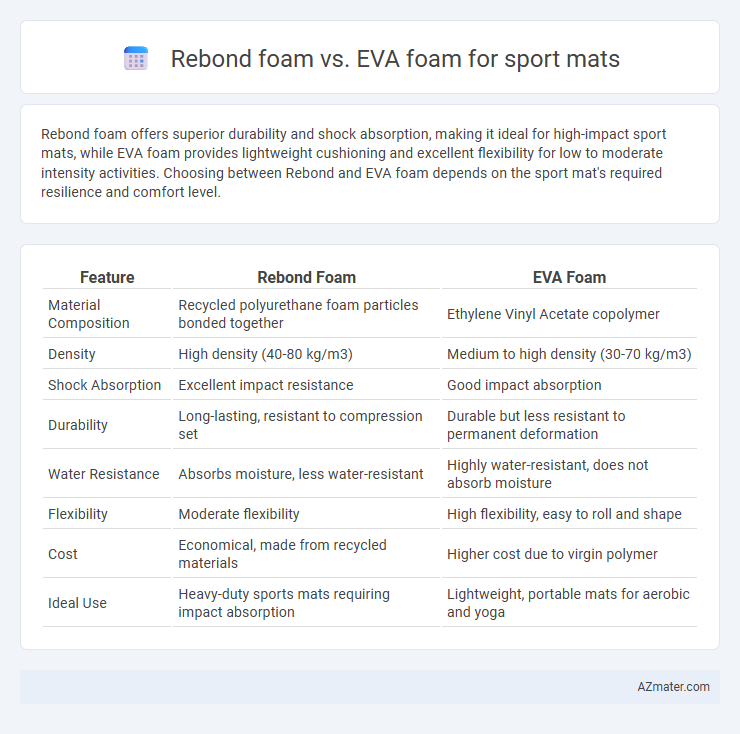Rebond foam offers superior durability and shock absorption, making it ideal for high-impact sport mats, while EVA foam provides lightweight cushioning and excellent flexibility for low to moderate intensity activities. Choosing between Rebond and EVA foam depends on the sport mat's required resilience and comfort level.
Table of Comparison
| Feature | Rebond Foam | EVA Foam |
|---|---|---|
| Material Composition | Recycled polyurethane foam particles bonded together | Ethylene Vinyl Acetate copolymer |
| Density | High density (40-80 kg/m3) | Medium to high density (30-70 kg/m3) |
| Shock Absorption | Excellent impact resistance | Good impact absorption |
| Durability | Long-lasting, resistant to compression set | Durable but less resistant to permanent deformation |
| Water Resistance | Absorbs moisture, less water-resistant | Highly water-resistant, does not absorb moisture |
| Flexibility | Moderate flexibility | High flexibility, easy to roll and shape |
| Cost | Economical, made from recycled materials | Higher cost due to virgin polymer |
| Ideal Use | Heavy-duty sports mats requiring impact absorption | Lightweight, portable mats for aerobic and yoga |
Introduction to Rebond Foam and EVA Foam
Rebond foam consists of shredded and bonded foam scraps, providing high-density cushioning ideal for heavy-impact sports mats due to its durability and superior shock absorption. EVA foam (ethylene-vinyl acetate) offers a lightweight, flexible, and closed-cell structure that delivers excellent resilience and water resistance, making it popular for sports mats requiring comfort and easy maintenance. Understanding these material properties helps in selecting the right foam that balances support, longevity, and performance for specific athletic applications.
Key Differences Between Rebond Foam and EVA Foam
Rebond foam, made from shredded polyurethane scraps fused together, offers superior density and durability, ideal for high-impact sports mats requiring firm support and shock absorption. EVA foam, composed of ethylene-vinyl acetate copolymer, provides lighter weight, enhanced flexibility, and excellent cushioning, making it suitable for mats emphasizing comfort and ease of movement. Key differences include rebound foam's higher hardness and resilience versus EVA's softer, more elastic properties and resistance to water and UV exposure.
Durability Comparison: Rebond vs. EVA Foam
Rebond foam offers superior durability for sport mats due to its dense structure made from recycled foam scraps compressed together, providing excellent resilience against impact and heavy use. EVA foam is lighter and more flexible but tends to compress and degrade faster under constant stress and high-traffic conditions. For long-lasting sport mat applications, rebond foam outperforms EVA foam in maintaining shape and structural integrity over time.
Cushioning and Impact Absorption
Rebond foam offers superior cushioning and impact absorption for sport mats due to its dense composition made from recycled foam scraps bonded together, providing excellent shock resistance and durability. EVA foam, while lightweight and flexible, delivers moderate cushioning with good impact absorption but tends to compress more quickly under heavy or repeated use. Rebond foam's higher density and resilience make it ideal for high-impact activities, whereas EVA foam suits lighter, low-impact sports environments.
Safety Features for Sports and Fitness
Rebond foam offers superior shock absorption and density compared to EVA foam, reducing the risk of impact injuries on sports mats. Its firm yet resilient structure provides enhanced joint protection during high-intensity workouts and aerobic exercises. EVA foam, while lighter and more flexible, typically provides less stability and cushioning, making rebond foam the safer choice for rigorous sports and fitness activities.
Ease of Maintenance and Cleaning
Rebond foam sports mats offer a denser composition that resists dirt and stains better than EVA foam, simplifying routine maintenance. EVA foam mats, while lighter and more flexible, tend to absorb moisture and dirt more easily, requiring more frequent and thorough cleaning. The closed-cell structure of rebond foam allows for quick wiping and less absorption, making it ideal for high-traffic sports areas where ease of cleaning is essential.
Cost Analysis: Rebond Foam vs. EVA Foam
Rebond foam typically offers a lower upfront cost compared to EVA foam, making it a budget-friendly option for sports mats, especially in bulk purchases. EVA foam, while more expensive, provides superior durability and longer lifespan, which may reduce replacement costs over time. Cost analysis should balance initial investment with performance factors such as compression resistance and maintenance to determine the best value for sports mat applications.
Environmental Impact and Sustainability
Rebond foam, made from recycled foam scraps, significantly reduces landfill waste and supports circular economy practices in sport mat production. EVA foam, while durable and lightweight, is derived from non-renewable petrochemicals and often poses challenges in biodegradability and recycling. Choosing rebond foam enhances sustainability by minimizing environmental footprint and promoting eco-friendly manufacturing in athletic flooring.
User Reviews and Professional Recommendations
Rebond foam offers superior durability and firm support, favored in high-impact sports mats for its ability to withstand heavy use, according to numerous user reviews highlighting long-lasting performance. EVA foam is praised by professionals for its lightweight, cushioning properties and excellent shock absorption, making it ideal for activities requiring softer support and portability. User feedback often notes EVA foam's comfort in low-impact exercises, while experts recommend rebond foam for rigorous training environments due to its resilience and density.
Final Verdict: Choosing the Right Foam for Sport Mats
Rebond foam offers superior durability and shock absorption, making it ideal for high-impact sports mats that require consistent performance and long-term resilience. EVA foam provides excellent cushioning and lightweight flexibility, suited for low to moderate impact activities and portable mat options. Choose rebond foam for heavy-duty, long-lasting sport mats and EVA foam for versatile, comfortable, and easy-to-handle mats tailored to lighter exercises.

Infographic: Rebond foam vs Eva foam for Sport mat
 azmater.com
azmater.com